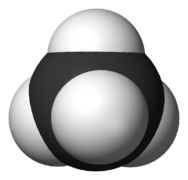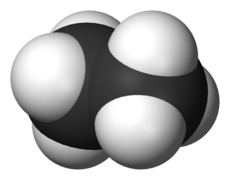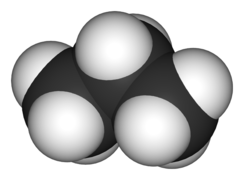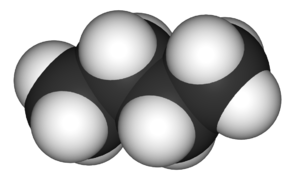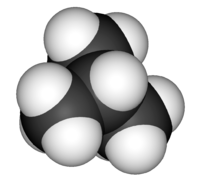Alkane: Difference between revisions
J.williams (talk | contribs) m (1 revision imported) |
m (1 revision imported) |
||
| (10 intermediate revisions by 2 users not shown) | |||
| Line 1: | Line 1: | ||
[[Category:Done | [[Category:Done 2021-01-31]] | ||
<onlyinclude>An '''alkane''' is | [[Category: Translated to French]] | ||
[[fr:Alcane]] | |||
<onlyinclude>An '''alkane''' is a type of [[hydrocarbon]] that contains only single bonds between the central carbon atoms. Alkanes are true hydrocarbons, meaning they contain only [[hydrogen]] and [[carbon]] atoms.</onlyinclude><ref>“Alkanes,” Chemistry LibreTexts, 28-Nov-2016. [Online]. Available: http://chemwiki.ucdavis.edu/Organic_Chemistry/Hydrocarbons/Alkanes. [Accessed: 19-May-2017].</ref> Alkanes are also referred to as ''[[saturated hydrocarbons]]'' since they have the maximum number of hydrogen atoms per carbon atom, versus the [[unsaturated hydrocarbons]] (alkenes and alkynes) which contain fewer hydrogen atoms per carbon atom.<ref>"Unsaturated Hydrocarbons - Chemistry LibreTexts", chem.libretexts.org, 2019. [Online]. Available: https://chem.libretexts.org/Bookshelves/General_Chemistry/Map%3A_Chemistry_-_The_Central_Science_(Brown_et_al.)/25%3A_Chemistry_of_Life%3A_Organic_and_Biological_Chemistry/25.04%3A_Unsaturated_Hydrocarbons. [Accessed: 14-Jun-2019].</ref> | |||
Alkanes | Alkanes have the [[molecular formula]] C<sub>'''''n'''''</sub>H<sub>2'''''n'''''+2</sub>, where '''''n''''' refers to the '''''n'''''umber of carbon [[atom]]s, and can be any natural number (1, 2, 3, ...). | ||
Take for example the three simplest alkanes: | |||
{| class="wikitable" | |||
|- | |||
! Name !! "n" !! Formula | |||
|- | |||
| [[methane]] || 1 || CH<sub>4</sub> | |||
|- | |||
|[[ethane]] || 2 || C<sub>2</sub>H<sub>6</sub> | |||
|- | |||
| [[propane]] || 3 || C<sub>3</sub>H<sub>8</sub> | |||
|} | |||
<gallery mode = " packed" | caption="Space-Filling Models of the Three Simplest Alkanes" |align=left> | |||
File:Methane-3D-vdW.png|link=Methane|Figure 1. Methane.<ref>https://commons.wikimedia.org/wiki/File:Methane-3D-vdW.png</ref> | |||
File:613px-Ethane-3D-vdW.png|link=Ethane|200px|Figure 2. Ethane.<ref>https://commons.wikimedia.org/wiki/File:Ethane-3D-space-filling.png</ref> | |||
File:640px-Propane-3D-space-filling.png|link=Propane|Figure 3. Propane.<ref>https://commons.wikimedia.org/wiki/File:Propane-3D-space-filling.png</ref> | |||
</gallery> | |||
While these examples are very simple alkanes, larger molecules can be branched or cyclic (containing a ring of carbon atoms). The names of all alkanes end with the suffix '''-ane''' (e.g. meth'''ane'''). The chemical name of an alkane will include information about the number of carbons in the molecule (such as in the example molecules above) and their arrangement (whether there are branches on the central carbon chain, for example). <ref>"Alkanes", I. Hunt, ,[Online]. Available: http://www.chem.ucalgary.ca/courses/351/Carey5th/Ch02/ch2-4.html#nomenclature. [Accessed: 14-Jun-2019].</ref> | |||
When two molecules have same molecular formula, but have the atoms arranged in a different way, they are called [[chemical isomer | structural isomers]]. For example, both ''butane'' and ''2-methylpropane'' shown below have the same molecular formula C<sub>4</sub>H<sub>9</sub>, but have the carbon atoms arranged differently. | |||
<gallery mode = " packed" | caption="Space-Filling Models of Two Structural Isomers" |align=left> | |||
File:Butane-3D-space-filling.png |link=butane|Figure 4. Butane.<ref>https://en.wikipedia.org/wiki/Butane#/media/File:Butane-3D-space-filling.png</ref> | |||
File:Isobutane3.png|link=2-methylpropane|200px|Figure 2. 2-methylpropane.<ref>https://en.wikipedia.org/wiki/Isobutane#/media/File:Isobutane3.png</ref> | |||
</gallery> | |||
The major components of [[fossil fuel]]s are [[hydrocarbon]]s, including alkanes such as [[methane]] (CH<sub>4</sub>) - the major component of natural gas, [[propane]] (C<sub>3</sub>H<sub>8</sub>) - commonly used as BBQ fuel, [[butane]] (C<sub>4</sub>H<sub>10</sub>) -often used as lighter fuel and [[octane]] (C<sub>8</sub>H<sub>18</sub>) - an important component of gasoline. | |||
To learn more about alkanes, click [http://chemwiki.ucdavis.edu/Organic_Chemistry/Hydrocarbons/Alkanes here]. | To learn more about alkanes, click [http://chemwiki.ucdavis.edu/Organic_Chemistry/Hydrocarbons/Alkanes here]. | ||
==References== | ==References== | ||
{{reflist}} | {{reflist}} | ||
Latest revision as of 00:02, 27 September 2021
An alkane is a type of hydrocarbon that contains only single bonds between the central carbon atoms. Alkanes are true hydrocarbons, meaning they contain only hydrogen and carbon atoms.[1] Alkanes are also referred to as saturated hydrocarbons since they have the maximum number of hydrogen atoms per carbon atom, versus the unsaturated hydrocarbons (alkenes and alkynes) which contain fewer hydrogen atoms per carbon atom.[2]
Alkanes have the molecular formula CnH2n+2, where n refers to the number of carbon atoms, and can be any natural number (1, 2, 3, ...).
Take for example the three simplest alkanes:
| Name | "n" | Formula |
|---|---|---|
| methane | 1 | CH4 |
| ethane | 2 | C2H6 |
| propane | 3 | C3H8 |
- Space-Filling Models of the Three Simplest Alkanes
Figure 1. Methane.[3]
Figure 2. Ethane.[4]
Figure 3. Propane.[5]
While these examples are very simple alkanes, larger molecules can be branched or cyclic (containing a ring of carbon atoms). The names of all alkanes end with the suffix -ane (e.g. methane). The chemical name of an alkane will include information about the number of carbons in the molecule (such as in the example molecules above) and their arrangement (whether there are branches on the central carbon chain, for example). [6]
When two molecules have same molecular formula, but have the atoms arranged in a different way, they are called structural isomers. For example, both butane and 2-methylpropane shown below have the same molecular formula C4H9, but have the carbon atoms arranged differently.
The major components of fossil fuels are hydrocarbons, including alkanes such as methane (CH4) - the major component of natural gas, propane (C3H8) - commonly used as BBQ fuel, butane (C4H10) -often used as lighter fuel and octane (C8H18) - an important component of gasoline.
To learn more about alkanes, click here.
References
- ↑ “Alkanes,” Chemistry LibreTexts, 28-Nov-2016. [Online]. Available: http://chemwiki.ucdavis.edu/Organic_Chemistry/Hydrocarbons/Alkanes. [Accessed: 19-May-2017].
- ↑ "Unsaturated Hydrocarbons - Chemistry LibreTexts", chem.libretexts.org, 2019. [Online]. Available: https://chem.libretexts.org/Bookshelves/General_Chemistry/Map%3A_Chemistry_-_The_Central_Science_(Brown_et_al.)/25%3A_Chemistry_of_Life%3A_Organic_and_Biological_Chemistry/25.04%3A_Unsaturated_Hydrocarbons. [Accessed: 14-Jun-2019].
- ↑ https://commons.wikimedia.org/wiki/File:Methane-3D-vdW.png
- ↑ https://commons.wikimedia.org/wiki/File:Ethane-3D-space-filling.png
- ↑ https://commons.wikimedia.org/wiki/File:Propane-3D-space-filling.png
- ↑ "Alkanes", I. Hunt, ,[Online]. Available: http://www.chem.ucalgary.ca/courses/351/Carey5th/Ch02/ch2-4.html#nomenclature. [Accessed: 14-Jun-2019].
- ↑ https://en.wikipedia.org/wiki/Butane#/media/File:Butane-3D-space-filling.png
- ↑ https://en.wikipedia.org/wiki/Isobutane#/media/File:Isobutane3.png


